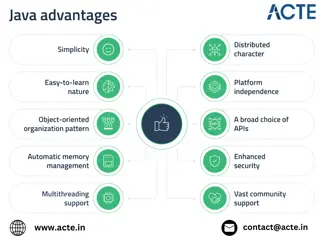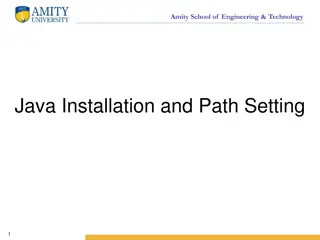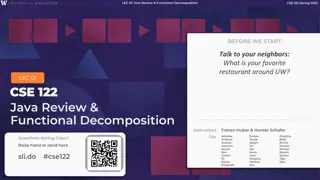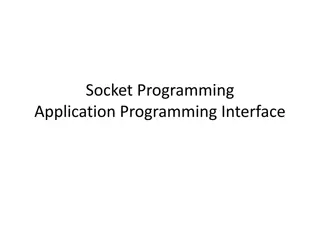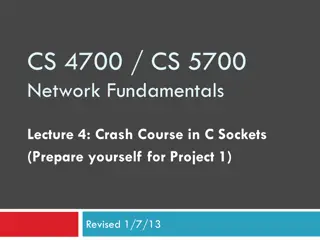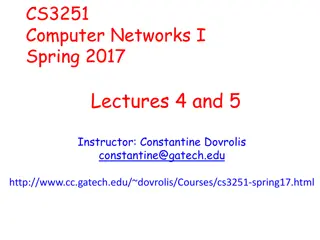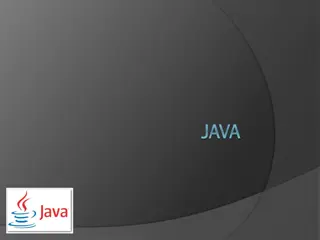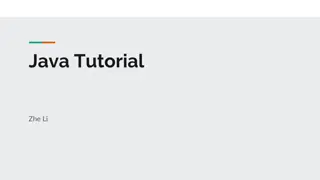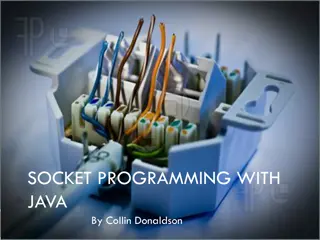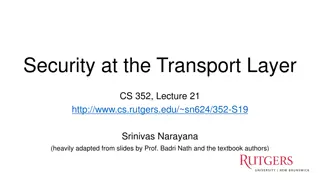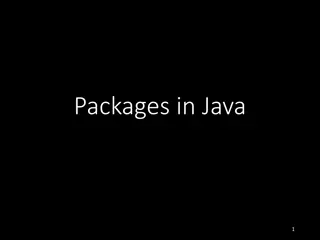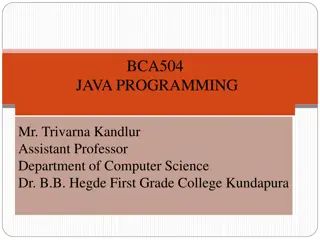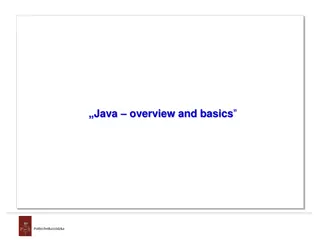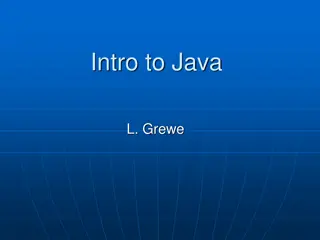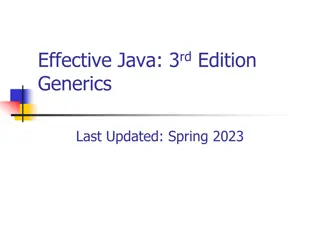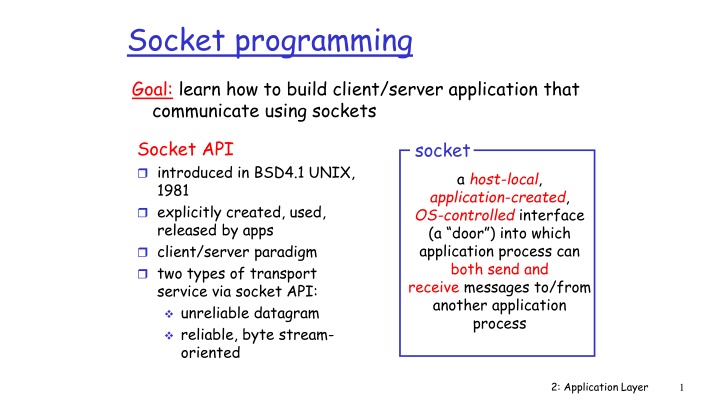
Socket Programming for Client/Server Communication
Explore the fundamentals of socket programming to build client/server applications that communicate using sockets. Learn about the Socket API introduced in BSD4.1 UNIX in 1981, the two types of transport services, and the layers involved in TCP socket programming. Discover how clients contact servers, the interaction process, and the reliable byte transfer between them.
Uploaded on | 1 Views
Download Presentation

Please find below an Image/Link to download the presentation.
The content on the website is provided AS IS for your information and personal use only. It may not be sold, licensed, or shared on other websites without obtaining consent from the author. If you encounter any issues during the download, it is possible that the publisher has removed the file from their server.
You are allowed to download the files provided on this website for personal or commercial use, subject to the condition that they are used lawfully. All files are the property of their respective owners.
The content on the website is provided AS IS for your information and personal use only. It may not be sold, licensed, or shared on other websites without obtaining consent from the author.
E N D
Presentation Transcript
Socket programming Goal: learn how to build client/server application that communicate using sockets Socket API introduced in BSD4.1 UNIX, 1981 explicitly created, used, released by apps client/server paradigm two types of transport service via socket API: unreliable datagram reliable, byte stream- oriented socket a host-local, application-created, OS-controlled interface (a door ) into which application process can both send and receive messages to/from another application process 2: Application Layer 1
Socket-programming using TCP Socket: a door between application process and end- end-transport protocol (UCP or TCP) TCP service: reliable transfer of bytes from one process to another controlled by application developer controlled by application developer controlled by operating system process socket process socket TCP with buffers, variables controlled by operating system TCP with buffers, variables internet host or server host or server 2: Application Layer 2
Socket programming with TCP Client must contact server server process must first be running server must have created socket (door) that welcomes client s contact Client contacts server by: creating client-local TCP socket specifying IP address, port number of server process When client creates socket: client TCP establishes connection to server TCP When contacted by client, server TCP creates new socket for server process to communicate with client allows server to talk with multiple clients source port numbers used to distinguish clients (more in Chap 3) application viewpoint TCP provides reliable, in-order transfer of bytes ( pipe ) between client and server 2: Application Layer 3
Client/server socket interaction: TCP Server (running on hostid) Client create socket, port=x, for incoming request: welcomeSocket = ServerSocket() TCP create socket, connect to hostid, port=x clientSocket = Socket() wait for incoming connection request connectionSocket = welcomeSocket.accept() connection setup send request using clientSocket read request from connectionSocket write reply to connectionSocket read reply from clientSocket close connectionSocket close clientSocket 2: Application Layer 4
Stream jargon keyboard monitor A stream is a sequence of characters that flow into or out of a process. An input stream is attached to some input source for the process, e.g., keyboard or socket. An output stream is attached to an output source, e.g., monitor or socket. inFromUser input stream Client Process process inFromServer outToServer output stream input stream client TCP clientSocket socket TCP socket to network from network 2: Application Layer 5
Socket programming with TCP Example client-server app: 1) client reads line from standard input (inFromUser stream) , sends to server via socket (outToServer stream) 2) server reads line from socket 3) server converts line to uppercase, sends back to client 4) client reads, prints modified line from socket (inFromServer stream) 2: Application Layer 6
Example: Java client (TCP) import java.io.*; import java.net.*; class TCPClient { public static void main(String argv[]) throws Exception { String sentence; String modifiedSentence; Create BufferedReader inFromUser = new BufferedReader(new InputStreamReader(System.in)); input stream Create client socket, connect to server Socket clientSocket = new Socket("hostname", 6789); DataOutputStream outToServer = new DataOutputStream(clientSocket.getOutputStream()); Create output stream attached to socket 2: Application Layer 7
Example: Java client (TCP), cont. Create BufferedReader inFromServer = new BufferedReader(new InputStreamReader(clientSocket.getInputStream())); input stream attached to socket sentence = inFromUser.readLine(); Send line to server outToServer.writeBytes(sentence + '\n'); modifiedSentence = inFromServer.readLine(); Read line from server System.out.println("FROM SERVER: " + modifiedSentence); clientSocket.close(); } } 2: Application Layer 8
Example: Java server (TCP) import java.io.*; import java.net.*; class TCPServer { public static void main(String argv[]) throws Exception { String clientSentence; String capitalizedSentence; Create welcoming socket at port 6789 ServerSocket welcomeSocket = new ServerSocket(6789); while(true) { Socket connectionSocket = welcomeSocket.accept(); Wait, on welcoming socket for contact by client BufferedReader inFromClient = new BufferedReader(new InputStreamReader(connectionSocket.getInputStream())); Create input stream, attached to socket 2: Application Layer 9
Example: Java server (TCP), cont Create output stream, attached to socket DataOutputStream outToClient = new DataOutputStream(connectionSocket.getOutputStream()); Read in line from socket clientSentence = inFromClient.readLine(); capitalizedSentence = clientSentence.toUpperCase() + '\n'; Write out line to socket outToClient.writeBytes(capitalizedSentence); } } } another client connection End of while loop, loop back and wait for 2: Application Layer 10
Chapter 2: Application layer 2.1 Principles of network applications 2.2 Web and HTTP 2.3 FTP 2.4 Electronic Mail SMTP, POP3, IMAP 2.5 DNS 2.6 P2P applications 2.7 Socket programming with TCP 2.8 Socket programming with UDP 2: Application Layer 11
Socket programming with UDP UDP: no connection between client and server no handshaking sender explicitly attaches IP address and port of destination to each packet server must extract IP address, port of sender from received packet UDP: transmitted data may be received out of order, or lost application viewpoint UDP provides unreliable transfer of groups of bytes ( datagrams ) between client and server 2: Application Layer 12
Client/server socket interaction: UDP Server (running on hostid) Client create socket, clientSocket = DatagramSocket() create socket, port= x. serverSocket = DatagramSocket() Create datagram with server IP and port=x; send datagram via clientSocket read datagram from serverSocket write reply to serverSocket specifying client address, port number read datagram from clientSocket close clientSocket 2: Application Layer 13
Example: Java client (UDP) keyboard monitor inFromUser input stream Client Process process Input: receives packet (recall thatTCP received byte stream ) Output: sends packet (recall that TCP sent byte stream ) receivePacket sendPacket UDP packet UDP packet clientSocket client UDP socket UDP socket to network from network 2: Application Layer 14
Example: Java client (UDP) import java.io.*; import java.net.*; class UDPClient { public static void main(String args[]) throws Exception { BufferedReader inFromUser = new BufferedReader(new InputStreamReader(System.in)); DatagramSocket clientSocket = new DatagramSocket(); InetAddress IPAddress = InetAddress.getByName("hostname"); byte[] sendData = new byte[1024]; byte[] receiveData = new byte[1024]; String sentence = inFromUser.readLine(); sendData = sentence.getBytes(); Create input stream Create client socket Translate hostname to IP address using DNS 2: Application Layer 15
Example: Java client (UDP), cont. Create datagram with data-to-send, length, IP addr, port DatagramPacket sendPacket = new DatagramPacket(sendData, sendData.length, IPAddress, 9876); clientSocket.send(sendPacket); DatagramPacket receivePacket = new DatagramPacket(receiveData, receiveData.length); clientSocket.receive(receivePacket); String modifiedSentence = new String(receivePacket.getData()); System.out.println("FROM SERVER:" + modifiedSentence); clientSocket.close(); } } Send datagram to server Read datagram from server 2: Application Layer 16
Example: Java server (UDP) import java.io.*; import java.net.*; class UDPServer { public static void main(String args[]) throws Exception { DatagramSocket serverSocket = new DatagramSocket(9876); byte[] receiveData = new byte[1024]; byte[] sendData = new byte[1024]; while(true) { DatagramPacket receivePacket = new DatagramPacket(receiveData, receiveData.length); serverSocket.receive(receivePacket); Create datagram socket at port 9876 Create space for received datagram Receive datagram 2: Application Layer 17
Example: Java server (UDP), cont String sentence = new String(receivePacket.getData()); InetAddress IPAddress = receivePacket.getAddress(); int port = receivePacket.getPort(); String capitalizedSentence = sentence.toUpperCase(); Get IP addr port #, of sender sendData = capitalizedSentence.getBytes(); DatagramPacket sendPacket = new DatagramPacket(sendData, sendData.length, IPAddress, port); serverSocket.send(sendPacket); } } } End of while loop, loop back and wait for another datagram Create datagram to send to client Write out datagram to socket 2: Application Layer 18


